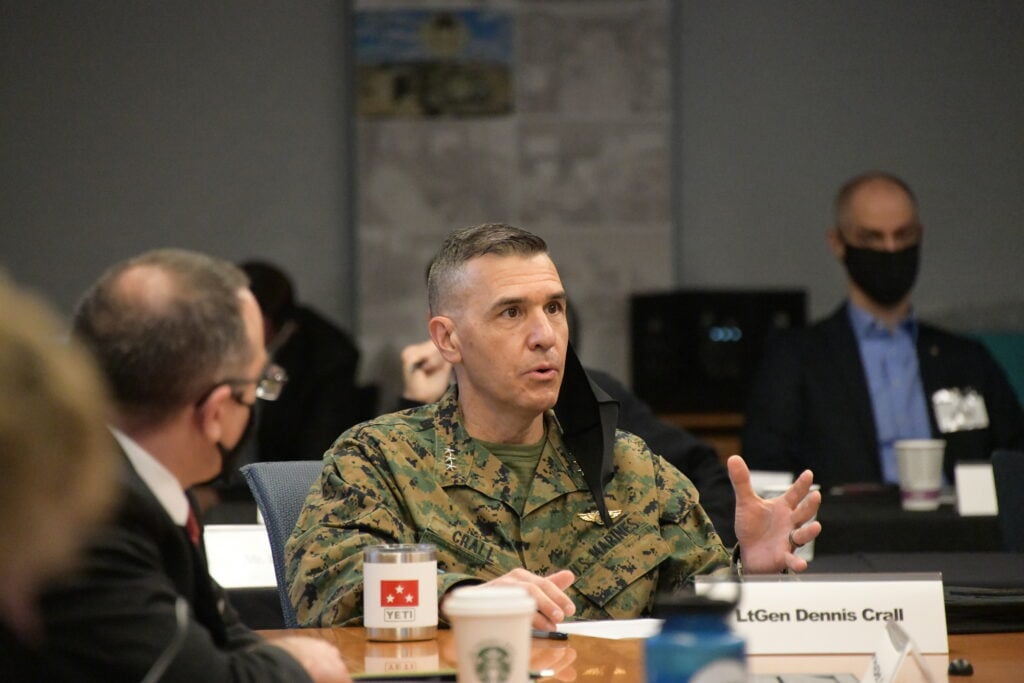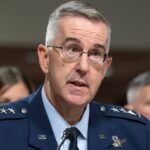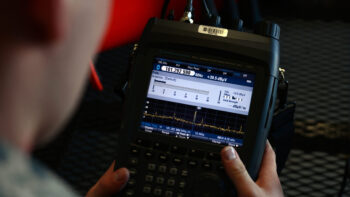
Lt. Gen. Dennis Crall, J6 director at the Jan. 26 JADC2 Data Summit
WASHINGTON: The top-level, classified strategy laying out the US military’s new approach to decision-making in any future conflict with peer adversaries — Joint All-Domain Command and Control (JADC2) — is about to hit the desk of Joint Chiefs of Staff Chair Gen. Mark Milley, says Marine Corps Lt. Gen. Dennis Crall, who leads the effort as the head of the J6.
“At this point, I can say that our work on the Joint Staff J6 — which was incredibly collaborative work — is reached its culminating point. So, we are on track to serve this up to the chairman here in the next couple of days,” he told me in an exclusive interview on Thursday. The J6 is the Joint Staff directorate for Command, Control, Communications, & Computers/Cyber.
Just as important as the strategy itself, Crall and members of his J6 team explained during our hour-long discussion, is the Joint Cross-Functional Team (CFT) that will serve as kind of a broker between the Joint Requirements Oversight Council (JROC) and the services in implementing the strategy. Under a revised charter just approved last week, the officials said, the CFT will have a first-of-a kind role in ensuring that both requirements and acquisition plans align with the JADC2 strategy — including a say in de-conflicting competing service efforts and funding decisions.
‘It’s not specifically restricted to just looking at the requirements piece, or the acquisition piece,” said Army Brig. Gen. Rob Parker, deputy director J6, and leader of the CFT. “The authorities in the charter also provide the CFT the opportunity to make recommendations on top line or zero-sum funding. Also, in conjunction with the DoD CIO, to give assessments to provide recommendations on the president’s budget, as well as any adjustments that might need to be made across the joint force in the program.”

JADC2, Lockheed Martin image
‘Lines of effort’ and milestones
The JADC2 strategy is separate from — but inexorably linked to — the Joint Warfighting Concept. The JADC2 strategy is a strategy for decison-making, not just a new C2 network.
The Joint Warfighting Concept, is the strategy outlining the new American way of war known as All Domain Operations; that is, next-generation, information-based wars using enormous amounts of fast computer analysis across the land, air, sea, space and cyberspace domains. The JADC2 strategy will feed into that concept across the board, Crall explained.
As drafted, the strategy has five so-called “lines of effort,” Crall told me Thursday. Those “should see us through the better part of our five- to 10-year horizon to keep us from being whipsawed, you know, every time a new idea comes along.”
While he wouldn’t go into specifics, he said no one will be surprised by the lines of effort because they represent the central challenges for JADC2 — data standardization, integrating allies and partners from the get-go, and improving networking capabilities across the military ecosystem.
Each of those lines of effort is further broken down into tasks and subtasks, with designated leads assigned for accomplishing each. An annex to the strategy includes milestones for achieving each of those tasks and subtasks. This way, Crall explained, the implementation plan for the JADC2 strategy is baked into the strategy right from day one.
“It’s not good enough to simply plan. We’ve got to be able to ensure that we’re doing what we’re pledging to do, or that if we can’t meet the timelines, we have good reasons why, and we know and understand the repercussions and how we adjust,” he said. “So, the implementation reporting is going to be multifaceted. That cross functional team has a role and responsibility to track the milestones that are inside the strategy.”

Gen. John Hyten
CFT Shifts Influence To Joint Staff
The JADC2 CFT includes representatives from the Combatant Commands, the services and myriad DoD offices and organizations — such as the Office of the Undersecretary for Acquisition and Sustainment (OUSDA&S), the Director of Test and Evaluation (DOT&E) and the Director of Cost Assessment and Program Evaluation (CAPE). That is, pretty much everybody “literally, across the third floor” of the Pentagon, said Stuart Whitehead, J6 deputy director for cyber and C4 integration, with a chuckle.
The CFT won’t have decision-making authority per se, the J6 officials were quick to stress. Nonetheless, it will have both influence on and the ear of, the JROC chair, Vice JCS Chairman Gen. John Hyten.
“So, the CFT is not empowered in the decision-making process, but they certainly are empowered to provide a better starting product for the general,” Crall said.
The revised charter “helps align the JADC2 CFT as a direct extension of the JROC — not with the JROC authorities, but with the ability to act on behalf of the JROC” in ensuring that requirements and capabilities being put forward in the Joint Capabilities Integration and Development System (JCIDS) process “better reflect the outcomes that we desire at the strategic level,” Parker explained.
The JCIDS is the much-criticized DoD requirements and evaluation system for new weapons.
“This really lets us do some of the hard work on behalf of the JROC to ensure when they actually get ready to make an authoritative decision on approving a requirement, it’s related to JADC2 they know that hard homework has been done,” he said.
“This is a change in the way that the JROC has historically worked,” said Whitehead. “So, this actually makes them more aware in terms of, we’ll say, top-down direction, as, as well as bottom-up requirements. In order for JADC2 to work, requirements — particularly at the enterprise level — have to be understood and documented in a way that so that we can describe our requirements to our acquisition counterparts in a more specific way than maybe what we had done previously.”
In January 2020, Hyten first signaled his intent to reform the JROC to make it more proactive, and speedier, in developing requirements, rather than simply waiting to respond to service plans. A month later he told Colin that JADC2 would require just such an upending of traditional JROC practices — with the JROC setting the attributes of JADC2 and the services building to those.
Crall said the change to the JADC2 CFT’s status “is slightly more empowering, in the sense that it opens the aperture up to speak about things that might, you know, even tangentially affect JADC2; the second piece is you have the ability across the engine rooms for this. If you think about it, because JADC2 has a fair number of parts to it, [by] getting the ability to share information and make discoveries [about] where we have today either tremendous overlaps or tremendous gaps, we then have the ability to work some of that out before that sits on the JROC floor,” he said.
“The whole idea behind making a JROC more efficient isn’t overwhelming it with battle rhythm events,” he said. “It’s refining these arguments, doing that hard homework ahead of time, and then [the plans are] served up so that decision-makers can make decisions.”
Crall said that it is too early to project when the new strategy might be finalized, although he did say he hopes an unclassified version will be released to the public. “Now, of course you know, the chairman will decide on on whether he wants this to go forward in its current form, or whether he wants it to be modified and corrected etc.,” Crall said.
And once Milley has signed off, the strategy will then go up to new Defense Secretary Lloyd Austin for approval. Given all the other issues already piled up on Austin’s desk — not the least of which is dealing with the spread of right-wing extremism and conspiracy theory beliefs within the ranks — that may take some time.






















